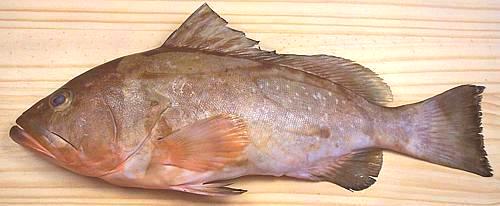 [Brown Grouper, Deer Grouper (Bahamas), Epinephelus morio]
[Brown Grouper, Deer Grouper (Bahamas), Epinephelus morio]
This West Atlantic fish is found from North Carolina to Southern Brazil and all around the Gulf of Mexico and Caribbean. It can grow to 49 inches and 50 pounds but the photo specimen was 16-1/2 inches and weighed 1-1/2 pound. This fish is Red Listed as NT (Near Threatened).
More on the Grouper Family
The flesh of this grouper is very white and delicate in flavor and texture. Small fillets hold together well enough for poaching if handled gently, and they flake apart very easily on the plate. It is easy to bone completely and an ideal fish for delicate sauces.
Grouper is called for in many cookbook recipes. Its characteristics make it desirable for upscale restaurants, and it isn't yet farmed so it is more expensive than many other fish.
Scales This fish is completely covered with smallish scales that adhere tightly and take some energy to scrape off. You may need to shave some of them off with the sharp edge of your kitchen knife, particularly at the edges, and may need to pull some with your long nosed pliers.
Cleaning: This isn't the easiest fish to clean as there are a lot of tough membranes inside. You'll want to cut the gill arches loose with your kitchen shears because they pull very hard.
Fillet: This is not a difficult fish to fillet, but dive sharply under the collar because there's quite a bit of flesh there. When you get down to the rib cage it's easiest to cut the ribs from the backbone and pull them from the fillet. There are some long sharp centerline spines for the length of the body cavity you should pull out with your long nose pliers. Pull straight forward as usual.
Yield: A 2-1/2 pound fish yielded 1 pound of skinless fillet (40%) - a decent yield and similar to other groupers.
Skin: The skin shrinks severely when fried so must be removed. Fortunately it's a relatively easy fish to skin using the usual long knife and cutting board Method.
Stock: There is an excellent fish for stock. There will still be quite a bit of flesh left on the head, and especially on the bottom of the collar, which is difficult to recover due to the bones. Stock made from the head, fins and bones is mild and quite usable. For details on making fish stock see our Fish Stock page.
sf_grouprdz 070505 - www.clovegarden.com